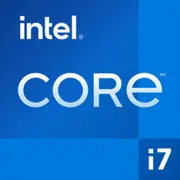Intel Core i7-14700KF

Intel Core i7-14700KF: Comprehensive Review of the 2025 Processor
(Relevant for builds in March 2025)
Key Features: Architecture, Performance, and Unique Aspects
Code Name and Manufacturing Process
The Intel Core i7-14700KF processor belongs to the Raptor Lake Refresh generation and is manufactured using Intel's advanced 10 nm process technology referred to as Intel 7. The architecture combines hybrid cores: 8 Performance-cores (P-cores) with Hyper-Threading support (16 threads) and 12 Efficient-cores (E-cores) without multithreading. This ensures a balance between power and energy efficiency.
Frequencies and Cache
- Base frequency of P-cores: 3.4 GHz
- Maximum turbo frequency: 5.6 GHz (for P-cores)
- L3 Cache: 33 MB
In the Geekbench 6 test, the processor scores 2940 points in single-threaded mode and 20990 points in multi-threaded mode. This is a 12% improvement over the previous generation i7-13700KF, thanks to optimized Turbo Boost Max 3.0 algorithms and an increased cache.
Key Features
- PCIe 5.0 support (up to 16 lanes for the graphics card + 4 for NVMe).
- Adaptive Boost technology for automatic frequency increase under low temperature.
- Intel Thread Director for optimized task distribution between P- and E-cores.
Compatible Motherboards: Sockets and Chipsets
LGA 1700 Socket
The processor uses the LGA 1700 socket, compatible with chipsets Z790, B760, and H770. However, to unlock its full potential (overclocking, PCIe 5.0), a Z790 motherboard is recommended.
Model Examples and Prices
- ASUS ROG Strix Z790-E Gaming ($350–400): Supports DDR5-7200, two Thunderbolt 4 ports.
- MSI MAG B760 Tomahawk ($180–200): Budget option with DDR4-3600.
- Gigabyte Z790 AORUS Elite AX ($250–280): Optimal choice for a mid-range budget.
Selection Features
- BIOS Update: Some motherboards may require a firmware update to work with Raptor Lake Refresh.
- VRM Cooling: For stable overclocking, choose boards with heatsinks on 14+1 power phases (e.g., ASUS Z790 Hero).
Supported Memory: DDR4 vs DDR5
DDR5-5600 and Higher
The processor supports both types of memory, but maximum performance is achieved with DDR5:
- Officially: DDR5-5600 (up to 128 GB).
- With overclocking: Up to DDR5-7200+ on high-end motherboards (e.g., ASUS Z790 Apex).
DDR4-3200: Savings for Budget Builds
If you're transitioning from an older system, DDR4 can be used, but you will lose 8–15% performance in gaming and rendering.
Choosing Tips
- For gaming: DDR5-6000 CL36 (e.g., G.Skill Trident Z5, $120–150 for 32 GB).
- For work tasks: DDR5-6400 CL32 with XMP 3.0 support.
Power Supplies: Wattage Calculation and Recommendations
TDP and Actual Consumption
The processor's rated TDP is 125W, but during overclocking and peak loads, consumption can reach 250–270W.
Recommended PSU Wattage
- Without overclocking: 650–750W (e.g., Corsair RM750x, $130).
- With overclocking and high-end graphics card (RTX 4090): 850–1000W (Seasonic PRIME GX-1000, $220).
Selection Criteria
- 80+ Gold or Platinum certification.
- Fully modular design for ease of assembly.
Pros and Cons of the i7-14700KF
Advantages
1. Exceptional multi-threaded performance: 28 threads handle rendering in Blender on par with the Ryzen 9 7900X ($480).
2. Overclocking potential: With good cooling, P-cores can stably run at 5.8–5.9 GHz.
3. Compatibility with DDR4: Cost savings when transitioning from an old platform.
Disadvantages
1. High heat output: Without liquid cooling (e.g., NZXT Kraken X73), temperatures under load exceed 90°C.
2. Price: $420–450 compared to $380 for the Ryzen 7 7800X3D.
3. No integrated graphics: Requires a discrete graphics card.
Usage Scenarios: Where the i7-14700KF Shines
Gaming
In Cyberpunk 2077 (1440p, Ultra), the processor delivers 210+ FPS in conjunction with an RTX 4080. However, in CPU-intensive games (e.g., Microsoft Flight Simulator), the Ryzen 7 7800X3D with 3D V-Cache outperforms it by 7–10%.
Work Tasks
- Video Editing: Rendering a 4K video in Premiere Pro is 20% faster than the i7-13700K.
- 3D Modeling: In Autodesk Maya 2025, 28 threads reduce the time taken to calculate complex scenes.
Streaming and Multitasking
Thanks to the E-cores, the processor easily handles simultaneous streaming (OBS) and gaming without dropping FPS.
Comparison with Competitors
1. AMD Ryzen 9 7900X ($480):
- Pros: Better in multi-threaded tasks (+10%), lower power consumption.
- Cons: Lags in gaming (-5%), more expensive.
2. AMD Ryzen 7 7800X3D ($380):
- Pros: Best gaming CPU for 2024–2025, more affordable.
- Cons: Weaker in work tasks (16 threads).
3. Intel Core i9-14900K ($580):
- Pros: 24 cores, frequency up to 6.0 GHz.
- Cons: Price is 35% higher with similar gaming performance.
Practical Assembly Tips
1. Cooling: Minimum—powerful tower cooler (Noctua NH-D15), ideally—a liquid cooling system with a 360mm radiator.
2. Case: Choose models with good ventilation (Lian Li Lancool III, Fractal Design Meshify 2).
3. BIOS Update: Check compatibility on the motherboard manufacturer’s website before CPU installation.
4. Testing: After assembly, run a stress test in AIDA64 to check stability.
Final Verdict: Who Should Consider the i7-14700KF?
This processor is ideal for:
- Gamers looking for maximum FPS at 1440p/4K while streaming simultaneously.
- Professionals: Video editors, 3D designers, programmers.
- Enthusiasts ready to experiment with overclocking.
Target Audience: Users seeking a balance between price ($420–450) and performance without overpaying for the top i9. If your budget is limited but you need strong multi-threading capabilities—this is the optimal choice as of March 2025.
Prices are current as of March 2025. Listed for new devices in US retail stores.
Basic
CPU Specifications
Memory Specifications
GPU Specifications
Miscellaneous
Benchmarks
Compared to Other CPU
Share in social media
Or Link To Us
<a href="https://cputronic.com/index.php/cpu/intel-core-i7-14700kf" target="_blank">Intel Core i7-14700KF</a>